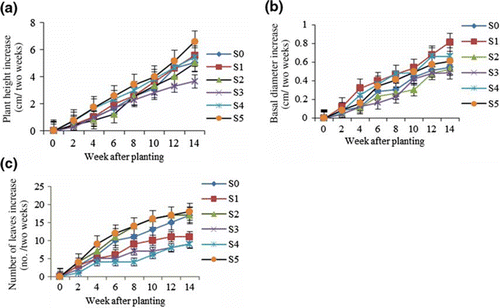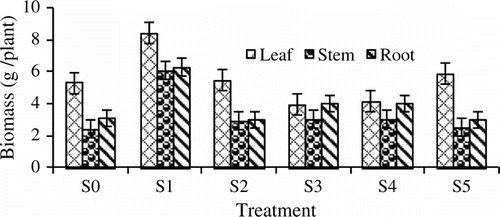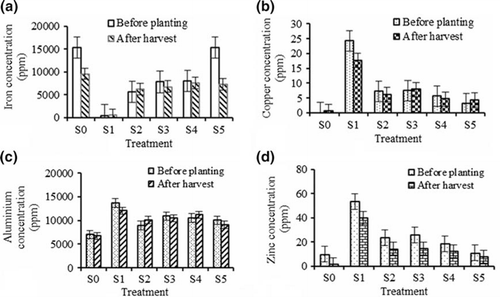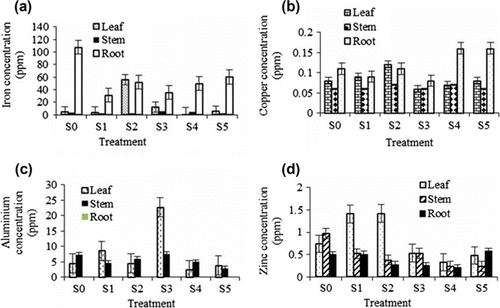Figures & data
Figure 1. Change in pH (a) and total carbon (%) (b) in the growth media at harvest of Justicia gendarussa as influenced by different treatments. Growth media indicates different proportion of textile factory sludge and soil, i.e. S0 = 100% soil, S1 = 100% textile factory sludge, S2 = 80% textile factory sludge + 20% soil, S3 = 60% textile factory sludge + 40% soil, S4 = 40% textile factory sludge + 60% soil and S5 = 20% textile factory sludge + 80% soil. Means ± SE are shown in error bar (p = 0.05).

Figure 2. Plant height (a), basal diameter (b) and number of leaves (c) of Justicia gendarussa at different weeks after planting as influenced by different treatments (increase per two weeks). Growth media indicates different proportion of textile sludge and soil, i.e. S0 = 100% soil, S1 = 100% textile factory sludge, S2 = 80% textile factory sludge + 20% soil, S3 = 60% textile factory sludge + 40% soil, S4 = 40% textile factory sludge + 60% soil and S5 = 20% textile factory sludge + 80% soil. Means ± SE are shown in error bar (p = 0.05).

Figure 3. Dry biomass of leaves, stems and roots of Justicia gendarussa at harvest as influenced by different treatments. Growth media indicates different proportion of textile sludge and soil, i.e. S0 = 100% soil, S1 = 100% textile factory sludge, S2 = 80% textile factory sludge + 20% soil, S3 = 60% textile factory sludge + 40% soil, S4 = 40% textile factory sludge + 60% soil and S5 = 20% textile factory sludge + 80% soil. Means ± SE are shown in error bars (p = 0.05).

Figure 4. Change in iron (a), copper (b), aluminium (c) and zinc (d) concentrations in the growth media after cultivation of Justicia gendarussa as influenced by different treatments. Growth media indicates different proportion of textile sludge and soil, i.e. S0 = 100% soil, S1 = 100% textile factory sludge, S2 = 80% textile factory sludge + 20% soil, S3 = 60% textile factory sludge + 40% soil, S4 = 40% textile factory sludge + 60% soil and S5 = 20% textile factory sludge + 80% soil. Means ±SE are shown in error bars (p = 0.05).

Figure 5. Iron (a), Copper (b), Aluminium (c) and Zinc (d) accumulation in different parts of Justicia gendarussa as influenced by different treatments. Growth media indicates different proportion of textile sludge and soil such as S0 = 100% soil, S1 = 100% textile factory sludge, S2 = 80% textile factory sludge + 20% soil, S3 = 60% textile factory sludge + 40% soil, S4 = 40% textile factory sludge + 60% soil and S5 = 20% textile factory sludge + 80% soil. Means ± SE are shown in error bars (p = 0.05).
